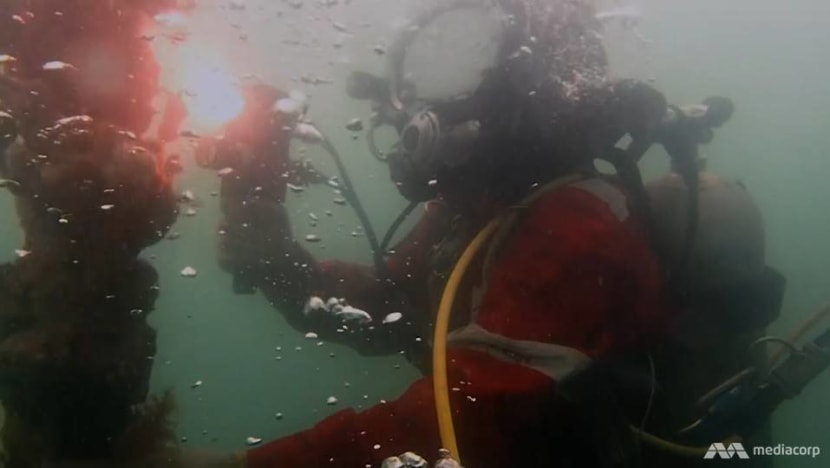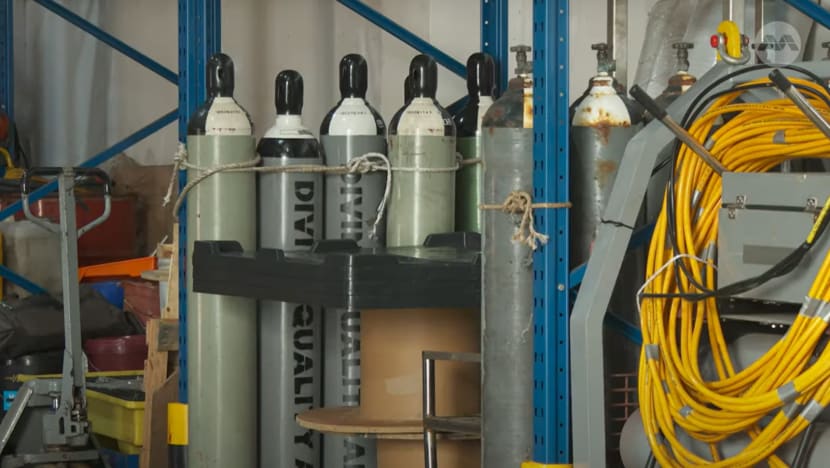Commercial diving association calls for licensing system for firms following fatal incidents
The lack of a licensing regime means commercial diving companies may not fully comply with the necessary guidelines in place, said the association’s chairman.


This audio is generated by an AI tool.
SINGAPORE: At a warehouse in Pioneer, trainee commercial divers spend up to four weeks getting familiar with equipment worth millions of dollars before taking to the waters.
Their company, diving contractor Subsea Global Solutions, employs around 40 divers to perform industrial or construction work underwater.
But first, they must undergo rigorous training for several months – a necessity given the numerous challenges of their work.
Recently, safety lapses have led to calls from industry players for authorities to introduce a licensing system for the sector.
The Ministry of Manpower announced last week that 12 commercial diving companies and seven individuals have been penalised for a total of 65 safety violations between September and December in 2024.
Last year, two commercial divers died at Singapore anchorages when they used recreational self-contained underwater breathing apparatus instead of the required commercial surface-supplied diving equipment.
This specialised safety gear allows commercial divers to get a continuous air supply from the surface through a hose known as a diving umbilical, which is connected to a specialised helmet.
This helps them to navigate challenging conditions like strong currents and low visibility.
NO LICENSING REGIME
Mr Alexis Chee, chairman of the Commercial Diving Association Singapore, noted that there is currently no licensing regime in place for commercial diving companies.
This lowers the barriers to entry and means that firms may not fully comply with the necessary guidelines that are in place, he cautioned.
During the COVID-19 pandemic period, there was also likely a lack of enforcement action that caused the market to “run at its own pace”, said Mr Chee.
“When, let’s say, someone with a little bit of funds just comes in and opens a commercial diving company in Singapore and engages trained divers, and then they are in business – that also reduces any kind of pressure on them to want to be able to fully comply (with the rules), to want to be able to fully excel in this industry,” he added.
Such companies will then save costs to maximise profits by “taking shortcuts”, he said.
“I’m personally welcoming of a licensing regime, and I do believe that it is a means to an end. Of course, we would want – in an ideal situation – for the industry to self-govern, and a licensing regime would actually function as a catalyst to help us get there,” Mr Chee told CNA.
The association actively engages companies on compliance and has an audit process for its member firms, he added.
He suggested a “softer approach” as well – recognising companies that have effective and established safety practices, such as by awarding them grants or funding for future investments.
SAFETY PRACTICES
At Subsea Global Solutions, its chief operating officer Satnam Kumar said the commercial diving firm has a dedicated safe practices manual, which guides divers on how to conduct operations in a safe manner.
The specialised helmets donned by its divers are also regularly serviced by certified workers, said Mr Kumar.
As for new divers, they take two to four weeks to get familiar with the equipment and safety management system before going onsite. There, they spend another three to four months observing and learning before they are allowed to perform dives.

The operations that the divers perform include underwater welding, which is necessary when a ship sustains underwater damage that could lead to water entering the vessel.
Challenging conditions in such situations, like low visibility, are what differentiate commercial diving from recreational diving, Mr Kumar noted.
RISING COSTS
Rising costs have also plagued the industry, he said. This includes ensuring equipment is up to par and sending divers for training or refresher courses.
The cost of equipment maintenance has gone up by at least 5 to 10 per cent year-on-year in recent years, which could add up to millions of dollars, Mr Kumar added.
Mr Chee pointed out how the pandemic brought about manpower changes to the industry.
“Once it was over, when the market restarted, we did see a lot of commercial divers who probably lost that kind of skillset and they needed a refresher. (There were also) new entrants (who) needed to undergo requisite training.”
With vessel arrivals reaching new highs at Singapore’s ports in the last two years, the association said demand for commercial diving services has also risen.
The lucrative industry means more companies are hopping on board as well.
“That attracts many business people to invest in diving, but they may or may not comply with all aspects of diving. That creates a danger for a pure investor to go into the diving business (compared with) a diving company investing with their experience and the finances.
“That kind of a setup is sustainable and would provide a consistent, safe operation,” Mr Kumar noted.



















